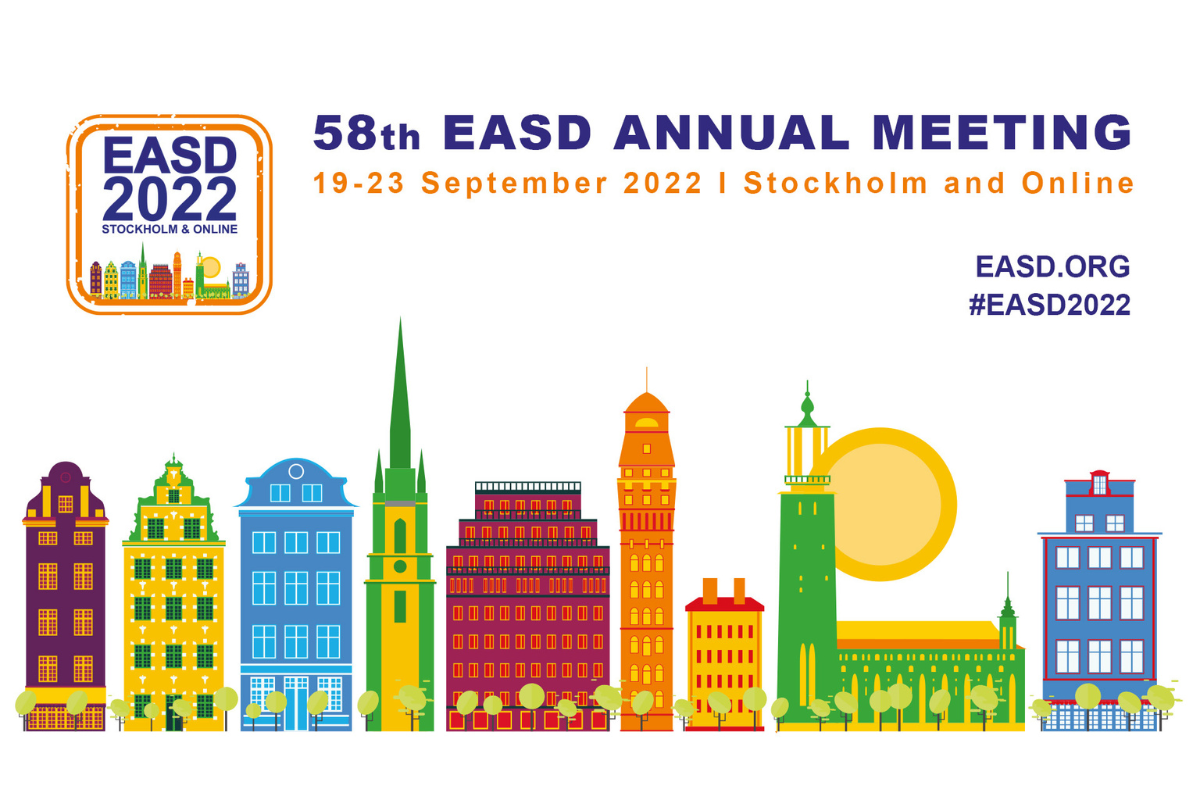Top Scientists Unite at the EASD Annual Meeting

Leading researchers gathered in Stockholm and virtually for the annual meeting of the European Association for the Study of Diabetes (EASD), which took place from September 19-23. There were more than 20,000 attendees and featured more than 30 studies presented by JDRF-funded researchers, funded now or in the past, working to find cures for type 1 diabetes (T1D) and improve the lives of those living with the disease today.
Here are a few highlights:
- Additional Therapies: Parth Narendran, FRCP, who has received 3 grants from JDRF, including a postdoctoral fellowship from 2001-2003, and Husam Ghanim, Ph.D., who is a co-principal investigator on a JDRF-funded “triple therapy” clinical trial, presented on adjunct therapies for T1D.
-
- Narendran highlighted SGLT therapy, which can lower your HbA1c levels, but comes with it an increased risk of developing diabetic ketoacidosis (DKA). He cites an analysis of InTandem trials, which showed a 7% reduction in cardiovascular risk with sotagliflozin (brand name Zynquista™), and DEPICT trial, which found a 13% and 31% reduction in kidney disease with 5 mg and 10 mg, respectively, on dapagliflozin (Farxiga®/Forxiga®) treatment. Dr. Narendran, however, highlighted that ketone sensors will be crucial to regulatory approval and access to these drugs. (Fortunately, as presented at EASD, a pivotal trial of Abbott’s integrated continuous glucose and ketone monitor will start in 2023. JDRF is also funding research to develop continuous ketone monitors, to prevent DKA, as well.)
DKA is a life-threatening complication that normally happens when blood sugar is very high. But with SGLT therapy, DKA can present with blood-sugar levels at normal or near it. Because of this, people with T1D on an SGLT therapy need to do ketone testing (ketoacidosis is an abundance of ketones in the blood), to avoid DKA and potential hospitalization.
-
- Ghanim advocated that “triple therapy”—SGLT + insulin + GLP, which encourages the release of insulin from the pancreas and reduces the release of glucagon—acts on different mechanisms that leads to synergistic actions that can help with A1c, weight, and total insulin dose.
- COVID-19 + T1D: The hypothesis is that SARS-CoV-2 (the virus that causes COVID-19 infections) is causing more people to develop T1D. We’ve covered it here (no connection) and here (diabetes incidence in COVID-positive individuals was 166% higher in the IQVIA cohort and 31% higher in the HealthVerity cohort), but we haven’t yet confirmed the hypothesis with a yes or a no, and at the EASD meeting we got both. In Norway, presented by German Tapia, Ph.D., a 63% increased risk for T1D more than 30 days after SARS-CoV-2 infection was found (but it did not account for family history of T1D), while, in contrast, presented by Helen Colhoun, M.D., the Scottish study only found an increased risk in the first few months of the pandemic, but, importantly, no association over a much longer time period. This data—and one from a publication last week showing that children who contracted COVID were 72% more likely to develop T1D—adds to the growing body of knowledge on the subject, but we still can’t draw any definitive conclusions.
- Artificial Pancreas Technology: In other Abbott news, the artificial pancreas system—using the FreeStyle Libre® 3 sensor, Ypsomed’s mylifeTM YpsoPump® insulin pump, and CamDiab’s CamAPS® FX algorithm and mobile app—will be launched in Germany later this year, and in Europe beginning in 2023. This is the first commercial system to come to market with an Abbott continuous glucose monitor (CGM).
JDRF funding helped create the algorithm and pump for this partnership. The algorithm was developed by Roman Hovorka, Ph.D., who had several JDRF grants from 2006 to 2019, coming to the UK market in 2020. Ypsomed has an active grant from JDRF, from 2018-2023, to develop a mylife™ insulin pump for artificial pancreas systems.
- Once-Weekly Insulin: Eli Lilly had the first data from its once-weekly basal insulin in people with T1D, showing an HbA1c at 6 months of 7.5% for the once-weekly and 7.3% for people taking insulin degluduc (brand name Tresiba®), Novo Nordisk’s ultra-long-acting insulin. Based on these results, Lilly has started a phase III clinical trial in people with T1D, and the results are slated for September 2023. (Novo Nordisk has a once-weekly basal insulin, insulin icodec, which is in phase III testing, as well. It was started in April 2021, and topline results were announced this summer, with icodec being comparable to degludec, however, there was a significantly higher rates of low blood sugar in people receiving icodec. The 26-week extension is ongoing, with full completion expected in December 2022.)
The next two conferences we’ll be covering are the Advanced Technologies & Treatments for Diabetes (ATTD), from February 22-25 in Berlin, and the JDRF-sponsored Network for Pancreatic Organ Donors with Diabetes (nPOD) Scientific Meeting, from February 26-March 1 in Fernandina Beach, Florida. Stay tuned for a precap and recap of these outstanding meetings!